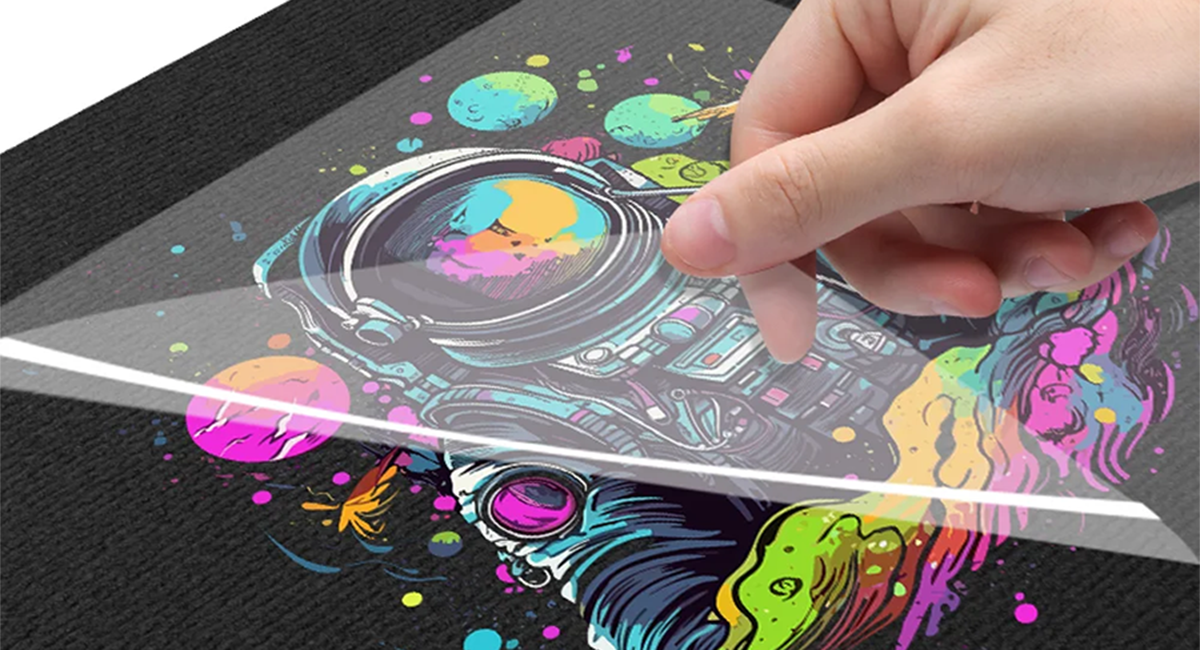The printing industry has witnessed remarkable advancements, particularly in the field of textile printing. Two prominent technologies today are DTF (Direct to Film) printing and traditional heat transfer printing (Sublimation Transfer). Although both methods use heat to transfer images, they have fundamental differences in principles, materials, and final results. This article will provide a detailed comparison of these two technologies to help you make the right investment or production decisions.
Traditional Heat Transfer Printing (Sublimation Transfer)
Sublimation printing uses special sublimation ink to print onto transfer paper. When pressed at a high temperature (usually 180°C or more), the ink converts from a solid to a gas (the sublimation process) and penetrates deep into the synthetic fabric fibers.

Characteristics (of Sublimation Transfer):
- Only effective on materials containing polyester or surfaces coated with a polymer layer.
- Must be printed on light-colored (usually white) fabrics, as sublimation ink does not have white and would be overpowered by the fabric’s background color.
- The printed image has a light, soft feel and no raised texture, because the ink penetrates into the fabric fibers.
DTF Direct to Film
DTF is an advanced digital printing method that allows images to be printed directly onto a specialized film (PET Film). This image layer is then transferred onto the material surface using heat and adhesive powder. This process offers numerous significant advantages over traditional printing methods. The printed image is heat-pressed to transfer it from the film to the fabric.

Characteristics:
- Can be printed on a wide range of materials, including cotton, blended fabrics, and polyester.
- Can print on dark fabrics thanks to a white ink layer that is printed as a base (underbase).
- The printed image has a thin film layer, giving it a slightly thicker and stiffer feel compared to sublimation transfer.
Advantages and Disadvantages of Each Technology
Heat Transfer (Sublimation)
Advantages:
- Excellent image quality: Vibrant, true-to-life colors that do not fade over time.
- Permanent durability: The ink penetrates deep into the fabric fibers, preventing peeling or cracking.
- Reasonable cost: Low initial investment cost and a simple, cost-effective production process.
Disadvantages:
- Material limitations: Can only be printed on polyester fabric and polymer-coated surfaces; cannot be printed on $100\%$ cotton.
- Color limitations: Cannot be printed on dark fabrics.
DTF Printing (Direct to Film)
Advantages:
- Versatility across all materials: This is the “highlight” of DTF. You can print on cotton, polyester, blends, silk, leather, and many other types of materials without having to change the printing process.
- Simple, time-saving process: DTF doesn’t require the fabric pretreatment step, helping you skip a costly process and saving time and labor.
- High durability: DTF prints have high resolution, along with superior durability, being water-resistant, UV-resistant, and won’t peel after multiple washes. The thin adhesive layer helps the print adhere firmly to the fabric surface.
- Economic efficiency: The initial investment cost for DTF machinery and supplies is lower than for DTG (Direct-to-Garment). Specifically, this technology allows you to print a large number of images onto film, then press them onto shirts gradually, optimizing the production process.
Disadvantages:
- Higher running cost: The running cost for materials (ink, film, adhesive powder) can be significantly higher than basic sublimation or simple HTV.
- Print feel: Due to the adhesive layer, the print is not as soft or breathable as a sublimated print.
When to Choose DTF, and When to Choose Heat Transfer?
You should choose Sublimation Heat Transfer when:
- You only need to print on polyester fabrics (typically sportswear, flags, polyester tote bags).
- You need to print on hard materials such as ceramic mugs, phone cases, ceramic tiles…
- You want prints with high durability, a soft feel, and no fading.
- You want to optimize initial investment costs.
You should choose DTF Printing when:
- You want to print on a wide variety of fabrics, especially cotton and dark-colored fabrics.
- You need to print complex designs with multiple colors and small details.
- You operate under a POD (Print on Demand) model or accept small-quantity, sample orders.
- You prioritize flexibility and production speed.
Choosing Technology – Choosing a Business Strategy
Heat transfer and DTF printing are not competitors but rather complementary solutions. While traditional heat transfer maintains its strong position in fields like sportswear printing or hard materials, DTF printing opens a new era for printing on diverse materials, meeting the needs for personalization and flexible production.

